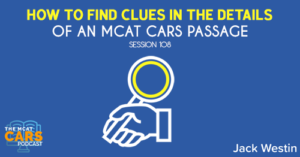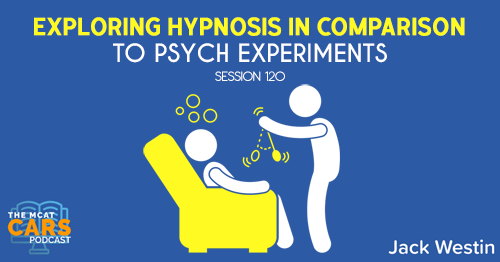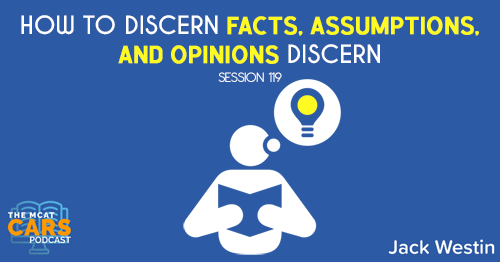Apple Podcasts | Google Podcasts
Session 108
Today’s passage is all about descriptions. Students need to be careful with how you read a passage. A lot of times, students read a passage like a newspaper but you can’t do that on this test. In this case, be careful with how you’re reading the details because they give you clues as to where the author is going.
You have to really consider every word and how they describe things. And that’s something we’re going to address today. We are breaking down a passage so that you can better understand how to break down your passages on the MCAT.
As always, I’m joined by Jack Westin from JackWestin.com. Check out all their amazing free resources including a free trial session of Jack’s full course to see how it’s like learning from Jack Westin himself. If you haven’t yet to sign up for their new science passages for free.
Listen to this podcast episode with the player above, or keep reading for the highlights and takeaway points.
Link to the article:
https://reallifemag.com/springtime-everywhere/
“If you look at Google Earth, it’s springtime everywhere,” explains Gopal Shah, Google Earth’s product manager, in a YouTube interview. In a TED talk he boasts that Google Earth is “cloud-free,” since the clouds and their shadows are edited out. “I like to think of this as Mother Earth’s best selfie,” he says, smiling indulgently. He pauses, as if waiting for the audience to laugh. But if Google Earth is the world’s selfie, does that make Google — the company taking the picture — into the world’s self? And how is this self and that selfie affecting the perceptions of our planet?
Though Google Earth may seem like a straightforward representation of the world as it is, it is actually made by stitching together millions and millions of pictures from various sources —satellites, planes, trekkers, cars — produced by Google itself or third-party suppliers. The result is not an objective mirror, as its seamless presentation in the Google Earth interface can make it appear, but a construction shaped by the countless decisions of humans and the algorithms they have programmed. The default images shown on Google Earth, for example, are not necessarily the most recent ones. Rather, it displays what it regards as the best imagery for each location, though the criteria for this are not disclosed.
Judging by what the app shows us, these decisions are governed not by an essential demand for accuracy but for clarity: for a certain smoothness that makes the representation seem plausible as Earth’s replica. Just as Instagram filters can remove blemishes, plump our lips, and thin our chins, Google Earth filters its representation of our planet, digitally nipping and tucking unpleasant weather patterns, harsher seasons, and the nighttime hours to render Earth as budding, healthy, and predominantly green. The version that feels “real,” that we’d prefer to be real, is not the one that is verifiably accurate but the one that’s easiest to consume, the one whose concerning blemishes have been fixed.
Earlier versions of Google Earth had a patchwork aesthetic that made its underlying constructedness more apparent: Images were visibly stitched together and colors were not quite aligned; there were rendering glitches and anomalies such as collapsed bridges and roads, collected, for instance, in screenshots by artist Clement Valla. “These jarring moments,” he argues in an essay for Rhizome, “expose how Google Earth works, focusing our attention on the software.” But in the 15 years since Google Earth’s launch, the company has worked to efface such evidence, overriding anomalies with a smoothed-out representation that masks the sources and the contexts in which images have been acquired and selected, meshing them into giant collage of renders and real-time images. As Valla explains, Google uses the Universal Texture — a mapping technology invented and patented by Google that allows it to extrude 3-D surfaces and models from two-dimensional images — to achieve this smoothing; he suggests that the company’s software and algorithms privilege the cloudless images that yield more realistic results. But this realism is not simply empirical.
[02:07] Paragraph 1, Sentence 1
“If you look at Google Earth, it’s springtime everywhere,” explains Gopal Shah, Google Earth’s product manager, in a YouTube interview.
Jack says:
We have Google Earth project manager, Gopal Shah here and talking about how springtime is everywhere. My assumption is just knowing what Google Earth is, meaning that the pictures they’re showing looks like springtime, and it’s not like winter or summer or anything. And springtime is usually seen as better than the winter time.
[03:11] Paragraph 1, Sentence 2
In a TED talk, he boasts that Google Earth is “cloud-free,” since the clouds and their shadows are edited out.
Jack says:
It’s a little bit more about the look of Google Earth. There are no clouds, they’re edited out. They quoted cloud-free so it’s probably a double meaning there. Of course, there are probably no clouds, but it probably also means it’s a happier kind of viewpoint.
[03:54] Paragraph 1, Sentence 3
“I like to think of this as Mother Earth’s best selfie,” he says, smiling indulgently.
Jack says:
Google Earth is taking pictures and photoshopping those images so that Mother Earth looks best.
[04:17] Paragraph 1, Sentence 4
He pauses, as if waiting for the audience to laugh.
Jack says:
So it’s a little joke that he’s waiting for a response. Just the way that it’s written as if waiting for the audience to laugh, but it wasn’t funny. Why would the audience laugh? So it seems like the author is critical of this position.
[04:54] Paragraph 1, Sentence 5
But if Google Earth is the world’s selfie, does that make Google — the company taking the picture — into the world’s self?
Jack says:
This is hard to understand. Well, let’s see if this gets cleared up in the end.
[05:20] Paragraph 1, Sentence 6
And how is this self and that selfie affecting the perceptions of our planet?
Jack says:
A selfie is when you’re taking a picture of yourself. So Google Earth is the selfie. That means Google is the self that is being photographed. So we open up with “it’s springtime and everywhere we edit out the clouds.” So it’s Mother Earth’s best selfie. Our hurricanes are increasing in strength and wildfires everywhere. And yet everyone goes to Google Earth and the world looks perfect.
[09:18] Paragraph 2, Sentence 1
Though Google Earth may seem like a straightforward representation of the world as it is, it is actually made by stitching together millions and millions of pictures from various sources —satellites, planes, trekkers, cars — produced by Google itself or third-party suppliers.
Jack says:
That’s why we’re having trouble reading it. Maybe the world isn’t as cloud-free, or happy, or springtime-y as Google Earth makes it seem like it is. You would usually take a selfie you want to edit but is that really you? So those are the kinds of concerns that the author is trying to bring up. And maybe it’s about perception.
Basically, the Instagram conundrum is put to a global scale of Google Earth and the view of the world. Everyone puts their best photos on Instagram, their best life is put out there, which we did as humans way before Instagram as well. You get in a fight with your spouse and argue with your kids. You walk out the door, you put a smile on your face. Everything’s perfect. And it seems, the Earth can’t get away from that either.
You registered what was going on in the first paragraph, which made it so much faster and easier to read. In the second paragraph, that’s what I tell all my students not to rush reading the first paragraph.
Having a better understanding of the first paragraph gives you a more solid foundation so it’s much easier to read. It’s hard to build a house if you don’t have that foundation set.
Read it as if you’re reading it to your best friend. Admit when you don’t understand something. Don’t pretend because it’s the worst thing you can do. Unfortunately, a lot of students tend to do that. Because we feel like it’s our role to do it when it’s not. Our role is to understand what we’re reading and to really engage with it, even if that means we don’t understand certain parts of it.
[11:32] Paragraph 2, Sentence 2
The result is not an objective mirror, as its seamless presentation in the Google Earth interface can make it appear, but a construction shaped by the countless decisions of humans and the algorithms they have programmed.
Jack says:
It says programmed so maybe they’re really manipulating it to some extent.
[12:16] Paragraph 2, Sentence 3
The default images shown on Google Earth, for example, are not necessarily the most recent ones.
Jack says:
It’s just an understanding of what we’re looking at. They’re maybe old, maybe new, we don’t know.
[12:31] Paragraph 2, Sentence 4
Rather, it displays what it regards as the best imagery for each location, though the criteria for this are not disclosed.
Jack says:
The author is giving us some insight into some negativity towards Google Earth and towards Google saying Google is doing all of this, showing us what they want to show us. And we just don’t have any idea why they’re doing it, and why they’re making the decisions they’re making. Humans are having a say of what goes up and what represents the earth.
[13:37] Paragraph 3, Sentence 1
Judging by what the app shows us, these decisions are governed not by an essential demand for accuracy but for clarity: for a certain smoothness that makes the representation seem plausible as Earth’s replica.
Jack says:
The author is criticizing Google by not showing us accurate information, but by showing us what Google wants for their representation of Earth.
They used the word clarity. And most students think accuracy and clarity aren’t synonymous. But not to this author. Clarity means something that’s clear, but you can have the wrong information. So it’s really an argument about objectivity. The author’s claiming that we’re subjective. We want something that’s nice-looking and clear, instead of objective and very accurate and something that represents it for what it actually is. So that’s the big takeaway message from the second paragraph and the third at this point.
[14:59] Paragraph 3, Sentence 2
Just as Instagram filters can remove blemishes, plump our lips, and thin our chins, Google Earth filters its representation of our planet, digitally nipping and tucking unpleasant weather patterns, harsher seasons, and the nighttime hours to render Earth as budding, healthy, and predominantly green.
Jack says:
So it’s just google making our Earth look its best, even if it’s not an accurate representation.
[15:37] Paragraph 3, Sentence 3
The version that feels “real,” that we’d prefer to be real, is not the one that is verifiably accurate but the one that’s easiest to consume, the one whose concerning blemishes have been fixed.
Jack says:
The author mentioned clarity at the beginning of this paragraph. “Easiest to consume” means that it doesn’t really impact you in a negative way. It makes you want to do it again and again. So a lot definitely is implied there.
[16:49] Paragraph 4, Sentence 1
Earlier versions of Google Earth had a patchwork aesthetic that made its underlying constructedness more apparent: Images were visibly stitched together and colors were not quite aligned; there were rendering glitches and anomalies such as collapsed bridges and roads, collected, for instance, in screenshots by artist Clement Valla.
Jack says:
It’s a little bit of history that the author is bringing up that Google Earth wasn’t always so clear and perfect. It used to have all these issues the author is talking about. And because the technology wasn’t there. It wasn’t good enough to hide it and camouflage it.
[17:52] Paragraph 4, Sentence 2
“These jarring moments,” he argues in an essay for Rhizome, “expose how Google Earth works, focusing our attention on the software.”
Jack says:
The author is basically saying that these moments of errors allow us to recognize that it’s just software at the end of the day.
[18:32] Paragraph 4, Sentence 3
But in the 15 years since Google Earth’s launch, the company has worked to efface such evidence, overriding anomalies with a smoothed-out representation that masks the sources and the contexts in which images have been acquired and selected, meshing them into giant collage of renders and real-time images.
Jack says:
This is the continuation 15 years since Google Earth launched and how we’re less focused on software because of all of the work they’re putting into it and trying to remove it. They’re purposely trying to make it seem like it’s all smooth and easy.
[19:17] Paragraph 4, Sentence 4
As Valla explains, Google uses the Universal Texture — a mapping technology invented and patented by Google that allows it to extrude 3-D surfaces and models from two-dimensional images — to achieve this smoothing; he suggests that the company’s software and algorithms privilege the cloudless images that yield more realistic results.
Jack says:
Here are some little nuts and bolts here of how Google does their thing and how they get it to look.
[19:52] Paragraph 4, Sentence 5
But this realism is not simply empirical.
Jack says:
It’s just going back to the same idea that it looks real. It’s realism, but it’s not data-driven. It’s not actually accurate. It’s something else. Usually, when we think of empirical, we think of facts. So it’s suggesting it’s not factual.
[20:25] Main Idea
'Be very careful with the details because they give you clues as to where the author's going.'Click To TweetIn the beginning, we noticed how the author sort of criticized Google Earth. And then, as it transitioned to the next paragraph, they brought in the word clarity. And if you’re not careful with how they represent clarity, you can be tricked on the questions.
For instance, a question that they could ask is, the author assumes that the clarity of Google Earth is based upon A. objectivity, B. subjectivity, C. something random. And the answer is obviously going to be subjectivity. It’s not objective. It’s not factual. And those are the kinds of questions they’ll also ask you about what the word represents.
And a lot of students right now are probably thinking about going back to the passage. But it just depends. If they define a word, sure, you can go back to the passage to figure out where they discussed it. But if it’s a random word, like clarity, they don’t really define it in one paragraph. It’s really part of the theme of the passage.
What the MCAT expects you to do is pick the answer that represents the passage as a whole for what that word means.
Use the main idea because the main idea encompasses the theme. And that theme is what drives that word. Now, they’re not saying the word will represent the main idea, but it will be relevant to the main idea and that should definitely help you pick out the right answer.
[22:20] What Jack Westin Has to Offer
Jack Westin has three brand new individual courses that focus on each section of the MCAT for the sciences. They also have a bundle where you get all three courses for a better price. They have a lot of trial sessions every week.
Links:
Link to the article:
SEARCH SITE
SEARCH SITE
LISTEN FOR FREE












